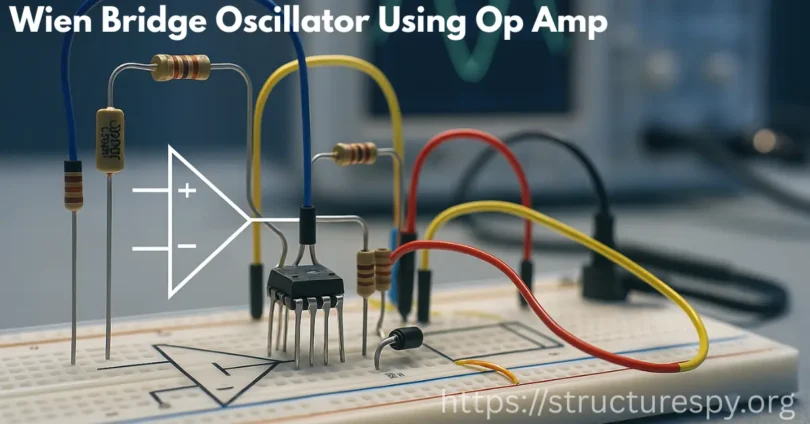The Wien Bridge Oscillator using Op Amp is a popular electronic circuit that creates smooth and stable sine waves. It works by using resistors, capacitors and an operational amplifier to produce continuous signals without any external input. This oscillator is easy to understand, reliable and widely used in audio and testing equipment. For beginners, it is one of the best ways to learn how oscillators work in real circuits.
Basic Concept of Oscillation
The basic concept of oscillation is about a signal that repeats its pattern again and again over time. In electronics, this means creating a wave that moves up and down in a regular way, such as a sound or voltage wave.To keep this wave repeating, the circuit uses an amplifier and feedback.
The amplifier makes the signal stronger and the feedback sends a small part of the output back to the input, keeping the process continuous. This is how an oscillator produces a steady waveform without needing any fresh input signal.
Components Used in Wien Bridge Oscillator
The Wien Bridge Oscillator using Op Amp is built with a few simple but important components. Each part plays a key role in making the circuit work properly. The main components are:
- Operational Amplifier (Op Amp): Acts as the main amplifier that boosts the signal and keeps the oscillation running.
- Resistors (R): Control the flow of current and help set the frequency of oscillation.
- Capacitors (C): Store and release electric charge, working with resistors to decide the frequency.
- Power Supply: Provides the necessary voltage for the Op Amp to work.
- Feedback Network: Made of resistors and capacitors, this network decides how much of the output signal is sent back to the input to keep oscillations stable.
These components form a balanced and steady oscillator that can generate smooth sine waves.
Circuit Diagram Overview
In the Wien Bridge Oscillator using Op Amp, the circuit diagram shows how all parts connect to create a smooth sine wave. The Op Amp is placed at the center of the circuit, acting as the amplifier. Around it, two resistors and two capacitors form the RC network, which decides the frequency of oscillation.
This RC network is connected in such a way that one part gives positive feedback to keep the oscillations going, while another part provides negative feedback to control the gain and prevent distortion. The output signal from the Op Amp is partly fed back to its input through this bridge network.
When the balance between feedback and gain is correct, the circuit begins to oscillate automatically, producing a steady and clean sine wave at the output.
Working Principle of Wien Bridge Oscillator
The Wien Bridge Oscillator using Op Amp works on the principle of positive and negative feedback. The circuit has an RC network that decides the frequency and an Op Amp that amplifies the signal.
When power is applied, a small noise signal inside the circuit starts the oscillation. The positive feedback from the RC network helps this small signal grow stronger until it forms a steady sine wave. At the same time, negative feedback keeps the signal from becoming too large or distorted by controlling the amplifier’s gain.
The oscillation continues as long as the loop gain is equal to one (unity). This means the amplifier gives just enough power to keep the signal going without any increase or loss in strength. As a result, the circuit produces a clean and stable sine wave output at the desired frequency.
Frequency of Oscillation Formula
The frequency of oscillation in a Wien Bridge Oscillator using Op Amp depends on the values of the resistors and capacitors in its RC network. The formula to find the frequency is:
𝑓
1
f= _____
2πRC
Here:
- f = Frequency of oscillation (in Hertz, Hz)
- R = Resistance (in ohms, Ω)
- C = Capacitance (in farads, F)
This formula shows that the frequency is controlled by the resistor and capacitor values. If the resistance or capacitance increases, the frequency decreases and if they decrease, the frequency increases. By choosing the right values for R and C, you can easily set the oscillator to generate a specific frequency for your project.
Advantages of Wien Bridge Oscillator
The Wien Bridge Oscillator using Op Amp has several advantages that make it one of the most popular and reliable oscillators in electronics. Some of its main benefits include:
- Pure Sine Wave Output: It produces a clean and smooth sine wave with very little distortion.
- Simple Design: The circuit is easy to build and requires only a few common components.
- Stable Frequency: The output frequency remains steady and does not change with time or temperature easily.
- Wide Frequency Range: By changing resistor or capacitor values, different frequencies can be generated.
- Good Amplitude Stability: The amplitude of the output signal stays constant without large variations.
The Wien Bridge Oscillator is widely used in signal generators, testing instruments and audio applications.
Common Applications
The Wien Bridge Oscillator using Op Amp is widely used in many electronic and testing devices because of its simple design and stable output. Some common applications include:
- Signal Generators: Used to produce smooth sine waves for testing and research.
- Audio Frequency Oscillators: Helps in testing audio amplifiers and sound systems.
- Function Generators: Works as part of laboratory equipment to generate different frequencies.
- Measurement Instruments: Used in devices that measure and analyze signals.
- Testing Circuits: Helps engineers check the performance of amplifiers and filters.
Because it provides a steady and distortion free output, this oscillator is a preferred choice in both educational and professional electronic projects.
Practical Example and Circuit Testing
To understand the Wien Bridge Oscillator using Op Amp better, you can build it on a breadboard and test its performance. Start by connecting the Op Amp, resistors and capacitors exactly as shown in the circuit diagram. Make sure the power supply is correct and all connections are tight.
Once the circuit is ready, turn on the power. The circuit should start oscillating automatically, producing a sine wave output. You can connect an oscilloscope to the output to observe the waveform and check its frequency. If the wave is not smooth or stable, adjust the resistor or capacitor values slightly until the oscillation becomes steady.
This simple experiment helps you see how feedback, gain, and the RC network work together. It is an easy and practical way to learn how oscillators generate continuous signals in real life.
Limitations of Wien Bridge Oscillator
While the Wien Bridge Oscillator using Op Amp is reliable and easy to use, it does have a few limitations to keep in mind:
- Limited Frequency Range: It works best for low and medium frequencies but not for very high frequencies.
- Component Accuracy Needed: Small changes in resistor or capacitor values can affect the output frequency.
- Temperature Sensitivity: The performance may vary slightly with temperature changes.
- Amplitude Distortion: If the gain is not properly controlled, the output sine wave can become distorted.
- Requires Stable Power Supply: Any fluctuation in the supply voltage can disturb the oscillation.
Despite these limitations, the Wien Bridge Oscillator remains a favorite choice for generating clean sine waves in many audio and lab applications.
Comparison | Wien Bridge vs Other Oscillators
The Wien Bridge Oscillator using Op Amp stands out from other oscillators because of its simplicity and quality of output. Here is how it compares:
- Wien Bridge vs RC Phase Shift Oscillator:
The Wien Bridge gives a purer sine wave with less distortion, while the RC Phase Shift Oscillator often needs extra tuning for stability. - Wien Bridge vs LC Oscillator:
The LC Oscillator works well at high frequencies, but it requires inductors, which are larger and more expensive. The Wien Bridge is better for low to medium frequencies and uses only resistors and capacitors. - Wien Bridge vs Crystal Oscillator:
The Crystal Oscillator offers very high frequency stability but is more complex and costly. The Wien Bridge is simpler, cheaper and easier to build for basic signal generation.
The Wien Bridge Oscillator is preferred when a clean, low frequency sine wave is needed with minimal circuit complexity.
Safety and Precautions
When working with the Wien Bridge Oscillator using Op Amp, it is important to follow a few safety steps to protect both yourself and the circuit:
- Check All Connections: Make sure wires and components are properly connected before turning on the power.
- Use Correct Power Supply: Always provide the voltage recommended for the Op Amp to avoid damage.
- Handle Components Carefully: Avoid touching metal parts when the circuit is powered to prevent short circuits.
- Double Check Polarity: Connect capacitors and the power supply with the correct polarity.
- Avoid Overheating: If any part gets too hot, disconnect the power and recheck the circuit.
You can safely test and operate your Wien Bridge Oscillator and ensure that it performs well without any risk of damage.
Common FAQs About Wien Bridge Oscillator Using Op Amp
Some faqs about Wien Bridge Oscillator Using Op Amp:
What type of waveform does a Wien Bridge Oscillator produce?
It produces a pure and smooth sine wave, which is useful for testing audio and signal equipment.
Why is the Op Amp preferred in a Wien Bridge Oscillator circuit?
The Op Amp provides high gain, good stability and easy control of output amplitude compared to transistor based designs.
Can the Wien Bridge Oscillator generate different frequencies?
Yes, By changing the values of the resistors or capacitors in the RC network, you can adjust the output frequency.
What condition is required for sustained oscillations?
The loop gain must be equal to one, meaning the amplifier’s gain and feedback balance perfectly to keep the signal steady.
How can distortion be reduced in the output signal?
Distortion can be minimized by using automatic gain control or a small lamp or diode in the feedback path to stabilize the amplitude.
What is the typical frequency range of a Wien Bridge Oscillator?
It usually works well in the range of 10 Hz to 1 MHz, depending on the components used.
What happens if the gain is set too high?
If gain is too high, the output signal will become distorted or clipped, ruining the purity of the sine wave.
Can a Wien Bridge Oscillator run on a single power supply?
Yes, it can work with a single or dual power supply, as long as the Op Amp supports it and the circuit is properly biased.
What is the main use of the RC network in this oscillator?
The RC network determines the oscillation frequency and provides the necessary phase shift for positive feedback.
How can we measure the output of a Wien Bridge Oscillator?
You can check the output using an oscilloscope to see the waveform or a frequency counter to measure its frequency accurately.
Conclusion
The Wien Bridge Oscillator using Op Amp is one of the simplest and most effective circuits for generating clean sine waves. It works on the balance of positive and negative feedback, using only resistors, capacitors and an operational amplifier. By adjusting the component values, different frequencies can be produced easily.
Because of its stability, smooth output and easy construction, this oscillator is widely used in laboratories, testing equipment and audio systems. Learning how it works helps students and beginners understand the core idea of oscillation and feedback in electronics. It is a great starting point for anyone who wants to explore practical circuit design and waveform generation.






